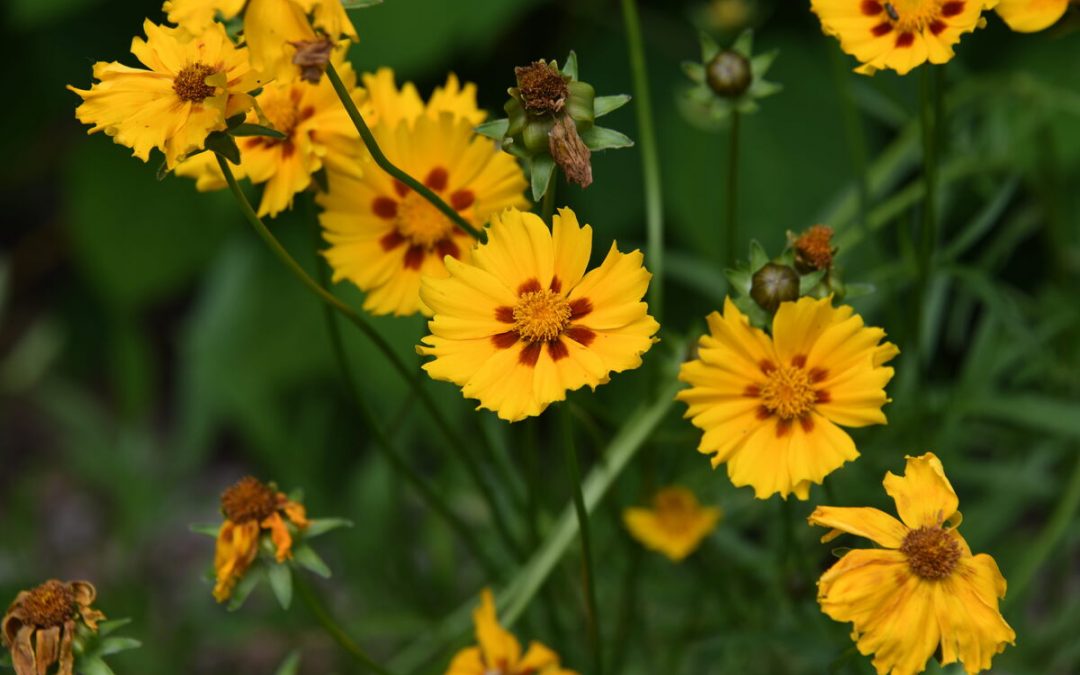Alabama is known for its natural beauty, including breathtaking mountains, pristine beaches, and attractive native plants. But Alabama’s native plants aren’t just pretty; they’re also low-maintenance and great for the ecosystem. Additionally, you can affordably plant most natives from seeds. So, we researched and compiled a list of the best native plants for Alabama.
Our list includes plants for North, Central, and South Alabama, and we break down each plant’s characteristics and regional preferences.
In this article:
- Oakleaf Hydrangea
- Boxelder Maple
- Green-and-Gold
- Wavyleaf Purple Coneflower
- Largeflower Tickseed
- Flowering Dogwood
- Pussytoes
- Red Maple
- Coral Honeysuckle
- Red Buckeye
- How to Choose Native Plants for Your Alabama Landscape
- FAQ About Native Alabama Plants
- Where to Find Native Plants in Alabama
10 Best Native Plants for Alabama
1. Oakleaf Hydrangea (Hydrangea quercifolia)
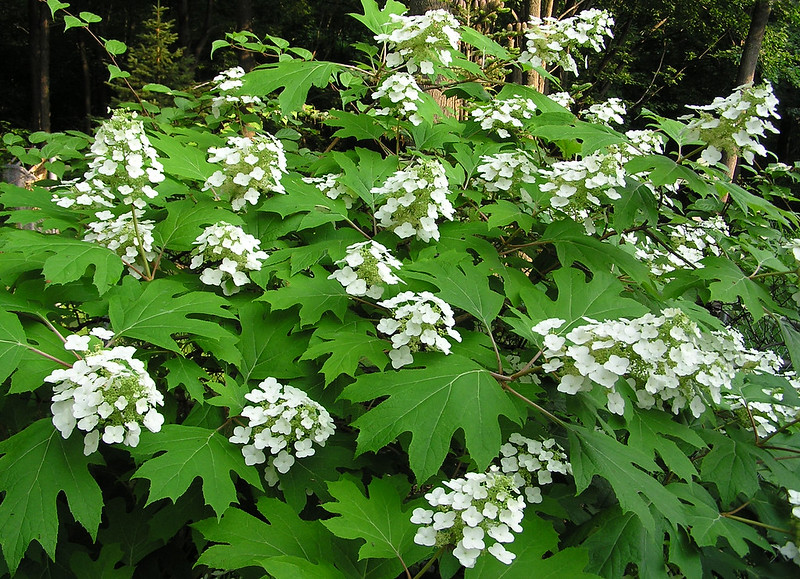
Photo Credit: normanack / Flickr / CC BY 2.0
Flourishing throughout the state, the oakleaf hydrangea has been Alabama’s state wildflower since 1999. It naturally grows in moist woodlands and along Alabama’s rivers and streams. Homeowners in all of Alabama’s regions plant oakleaf hydrangea as an ornamental because it’s beautiful and pollinator-friendly but resists most pests.
Oakleaf hydrangea is a sweet-smelling shrub with striking white flowers that bloom in spring, turn rose in the summer, and remain until mid-winter. Its exquisite flowers complement green oak-shaped leaves that turn vivid shades of red and purple come fall.
Plant type: Shrub
USDA Hardiness Zone: 5 to 9
Sun: Partial to full shade
Soil: Fertile, moist, well-drained
Duration: Perennial
Foliage: Deciduous
Fragrance: Honey-vanilla
Bloom time: Spring
Water needs: At least 1 inch a week
Mature height: 6 to 8 feet
Potential hazards: They resist pests, but sometimes get spiders or aphids and they are susceptible to leaf bright or powdery mildew.
Maintenance needs: Low-maintenance, only prune if the plant gets damaged or becomes overgrown. You may deadhead.
2. Boxelder Maple (Acer negundo)
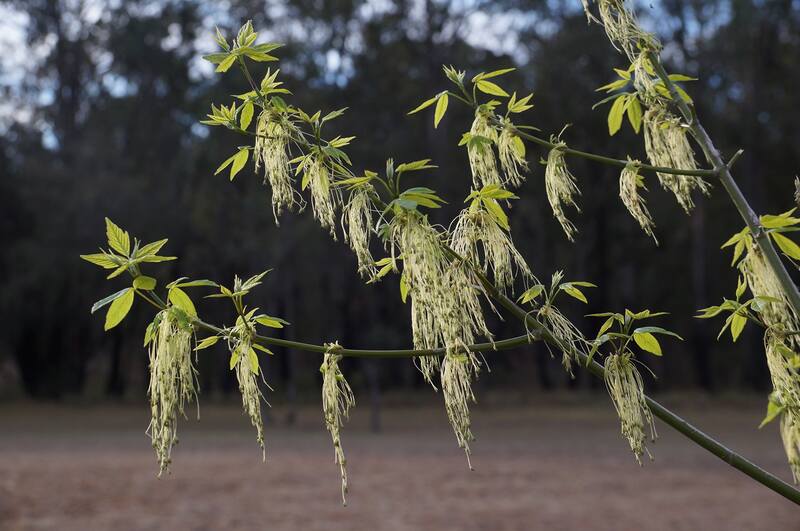
Photo Credit: Tatters / Flickr / CC BY 2.0
The boxelder maple, also called box elder, is a native shade tree that naturally grows on river banks and wetlands throughout the U.S. and Canada. It’s native throughout Alabama and typically lives 65 to 70 years.
Box elders are famous for their light-green leaves because it’s the only maple tree with compound leaves with more than three leaflets. Although its sap isn’t as sweet as sugar maple, it is sweet enough to make a tasty syrup.
Plant type: Tree
USDA Hardiness Zone: 2 to 9
Sun: Full sun to partial shade
Soil: Just about any well-drained soil
Duration: Perennial
Foliage: Deciduous
Fragrance: Mild
Bloom time: March – April
Water needs: Medium, drought tolerant
Mature height: 30 to 80 feet
Potential hazards: They are toxic to horses and some people get an allergic reaction from them. Their wood is weak and susceptible to storm damage.
Maintenance needs: Be careful not to overwater. It thrives best when the soil’s moisture varies.
3. Green-and-Gold (Chrysogonum virginianum)
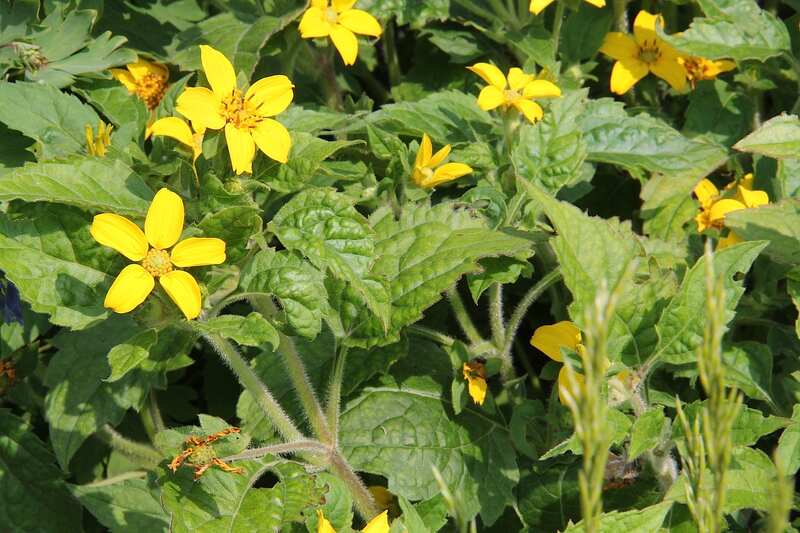
Photo Credit: Peter A. Mansfeld / Wikimedia Commons / CC BY 3.0
Green-and-gold, or goldstar, is a showy herb native to Southeast Alabama and Mobile County. Its star-shaped yellow flowers and hairy stems make it an excellent specimen plant and it’s also grown as groundcover. Green-and-gold is highly adaptable and resists most pests while attracting beneficial insects like bumble bees and butterflies.
Plant type: Herb
USDA Hardiness Zone: 5 to 9
Sun: Full to partial shade
Soil: Does best in soil that is moist, well-drained, and organically rich
Duration: Perennial
Foliage: Semi-evergreen
Bloom time: April – October
Water needs: Medium
Mature height: 6 to 12 inches
Potential hazards: It is susceptible to mildew
Maintenance needs: It is easy to care for.
4. Wavyleaf Purple Coneflower (Echinacea simulata)
Wavyleaf purple coneflower is native but rare throughout Alabama, Georgia, and Tennessee. Admired for their beauty, they have pink and purple flowers with drooping petals and a dark center. It is easy to grow and highly adaptable to just about any soil.
Many Alabamans choose wavyleaf purple coneflower as a specimen plant, and its flowers are used in bouquets and teas. It is also popular with wildlife lovers because its nectar attracts bees and butterflies, and its seeds attract birds.
Plant type: Herb
USDA Hardiness Zone: 5 to 8
Sun: Full sun to partial shade
Soil: Well-drained, calcareous, loam
Duration: Perennial
Foliage: Deciduous
Fragrance: Light and sweet
Bloom time: June – August
Water needs: Medium
Mature height: 2 to 3 feet
Potential hazards: Occasionally gets leaf spot and may attract the Japanese beetle.
Maintenance needs: Separate clumps when overcrowding occurs. Removing dead flowers isn’t required, but improves the plant’s appearance.
5. Largeflower Tickseed (Coreopsis grandiflora)
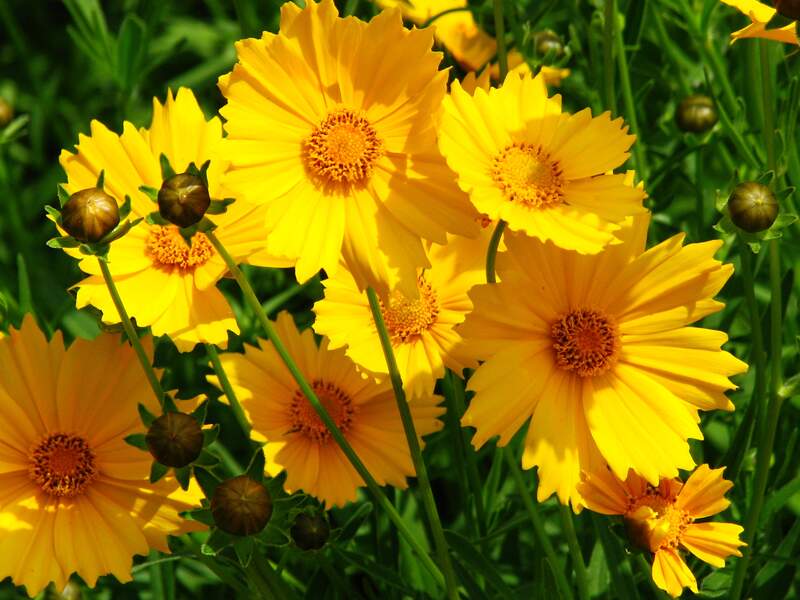
Photo Credit: Kor!An (Андрей Корзун) / Wikimedia Commons / CC BY-SA 3.0
Largeflower tickseed is an herb native to North and Central Alabama, including Jefferson, Shelby, Tuscaloosa, and Lee County. It is an excellent addition to any butterfly, wildflower, or rock garden, and its bright yellow flowers look beautiful beside wavyleaf purple coneflower.
It has fragrant flowers that attract butterflies, bees, and hummingbirds and it’s extremely low-maintenance. Additionally, largeflower tickseed is great for homeowners with small children or pets because it’s completely non-toxic.
Plant type: Herb
USDA Hardiness Zone: 4 to 9
Sun: Full sun
Soil: Well-drained, sand, loam, clay
Duration: Perennial, biennial
Foliage: Semi-deciduous
Fragrance: Sweet, spicey
Bloom time: Summer and fall
Water needs: Drought tolerant, 1 inch per week
Mature height: 1.5 to 2.5 feet
Potential hazards: Some people are allergic to tickseed. They are susceptible to fungal diseases such as powdery mildew. They may attract aphids, aster leafhoppers, or coreopsis beetles.
Maintenance needs: Low-maintenance, fertilize and deadhead to encourage robust blooms.
6. Flowering Dogwood (Cornus florida)
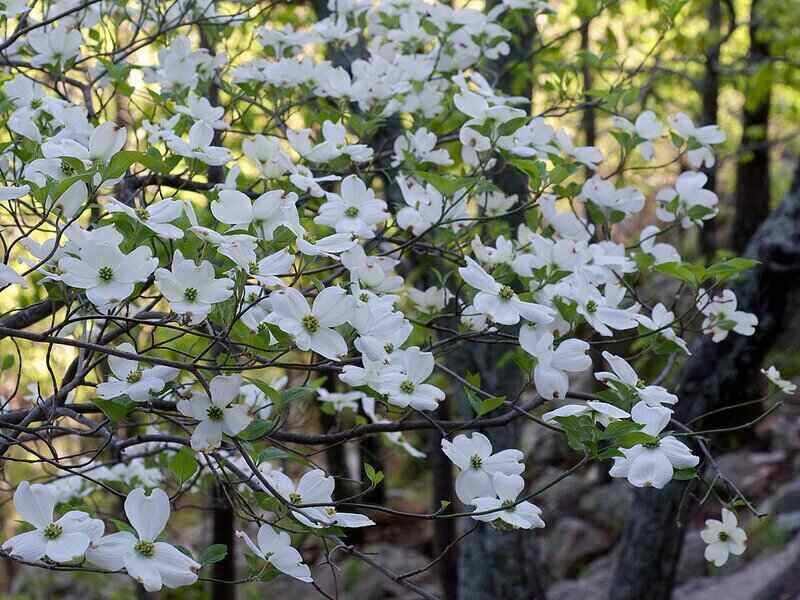
Photo Credit: Eric Hunt / Wikimedia Commons / CC BY-SA 4.0
The flowering dogwood is an attractive tree that natively grows throughout most of Alabama. It has fragrant clusters of small yellow-green flowers surrounded by pink and white petal-like leaves. Then, in the fall, its foliage turns vivid shades of red, purple, and scarlet, making a spectacular fall display.
In addition to its lavish flowers and leaves, flowering dogwood has an interesting bark with a pattern that resembles scales. However, it isn’t just desired for its looks; its hardwood is excellent for making household items, such as tool handles and butcher blocks, and its nectar attracts native pollinators.
Plant type: Tree
USDA Hardiness Zone: 5 to 9
Sun: Partial shade
Soil: Organically rich, moist, acidic soil
Duration: Perennial
Foliage: Deciduous
Fragrance: Sweet floral
Bloom time: Early spring
Water needs: Low
Mature height: 15 to 30 feet, but can be up to 65 feet
Potential hazards: Contact with its berries give some people rashes. It is susceptible to fungal diseases including powdery mildew and spot anthracnose.
Maintenance needs: Prune in early spring and fertilize during spring and fall.
7. Pussytoes (Antennaria Gaertn.)
Pussytoes are flowering herbs with colorful leaves that look great as groundcover, in rock gardens, and along pathways. They are native to North and Central Alabama, including Huntsville and Birmingham.
Its nectar-rich pink and white flowers bloom in early spring. Although you can expect to see pollinators, such as butterflies, in mid to late spring, pussytoes are deer resistant and don’t attract many pests.
Plant type: Herb
USDA Hardiness Zone: 3 to 8
Sun: Full sun
Soil: Well-drained
Duration: Perennial
Foliage: Semi-evergreen
Fragrance: None
Bloom time: April – June
Water needs: Dry to medium, Drought tolerant
Mature height: 3 to 9 inches
Potential hazards: If the soil is too moist, it can get root rot. You may get an allergic reaction if you are sensitive to ragweed, daisies, and marigolds.
Maintenance needs: Low-maintenance, deadheading will improve the plant’s appearance.
8. Red Maple (Acer rubrum)
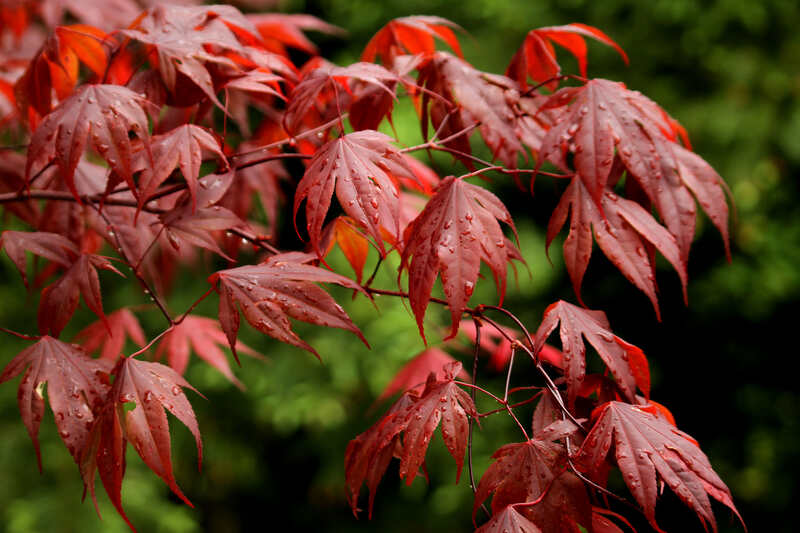
Photo Credit: Heng Wang / Wikimedia Commons / CC BY-SA 3.0
Red maples are beautiful shade trees that natively grow throughout all of Alabama. In fact, the red maple is so tolerant and adaptable that it natively grows as far north as Quebec and as far south as Key West. Although it is more common outside major cities, many red maples still thrive throughout Alabama’s urban areas.
The red maple is asymmetric with green leaves, red flowers, and red and pink fruit. However, it gets its name from its fabulous bright red fall foliage that mixes with shades of yellow and orange.
Plant type: Tree
USDA Hardiness Zone: 3 to 9
Sun: Full sun, partial shade
Soil: Chalk, clay, loam, sand
Duration: Perennial
Foliage: Deciduous
Fragrance: Sweet cherry or almond flower scent
Bloom time: March – April
Water needs: High
Mature height: 40 to 70 feet
Potential hazards: Toxic to horses
Maintenance needs: If you overwater, it may not grow to full height.
9. Coral Honeysuckle (Lonicera sempervirens)
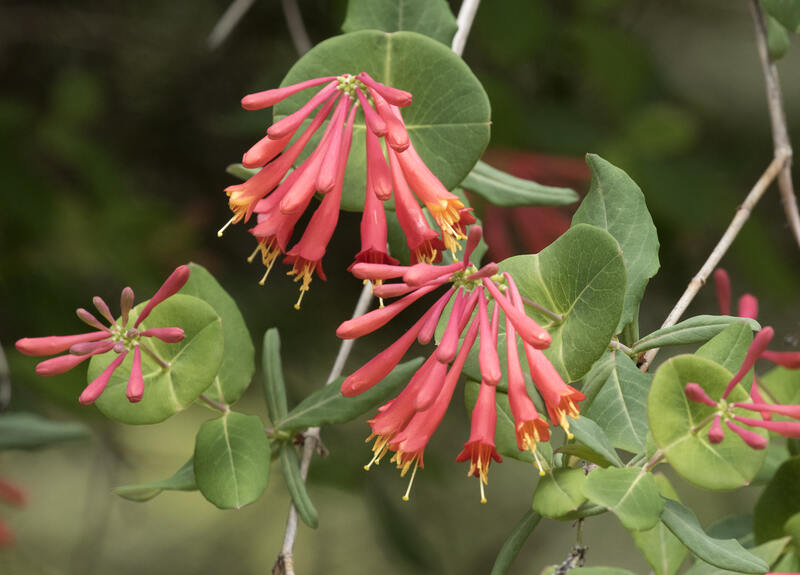
Photo Credit: Zeynel Cebeci / Wikimedia Commons / CC BY-SA 4.0
If you are looking to grow a native vine, consider coral honeysuckle. Many Alabamians shy away from honeysuckle due to the unruly growth of Japanese honeysuckle, but don’t be alarmed. Unlike the Japanese plant species, coral honeysuckle isn’t an invasive plant. Instead, it naturally grows throughout Alabama, living in harmony with the state’s plants and wildlife.
Many homeowners grow coral honeysuckle on trellises, while others prefer it as a groundcover. Its red and yellow flowers attract butterflies, bees, and hummingbirds, and its red berries and seeds attract several birds, including songbirds and cardinals.
Plant type: Vine
USDA Hardiness Zone: 4 to 11
Sun: Full sun to partial shade
Soil: Sand, loan, clay, slightly acidic, well-drained
Duration: Perennial
Foliage: Semi-evergreen
Fragrance: None
Bloom time: Late fall
Water needs: 1 inch per week, somewhat drought tolerant
Mature height: 15 to 20 feet
Potential hazards: Its red berries are toxic to humans and some pets, including dogs and cats. Its leaves are susceptible to aphid damage and leaf spot diseases.
Maintenance needs: It needs occasional pruning and well-drained soil will prevent disease.
10. Red Buckeye (Aesculus pavia)
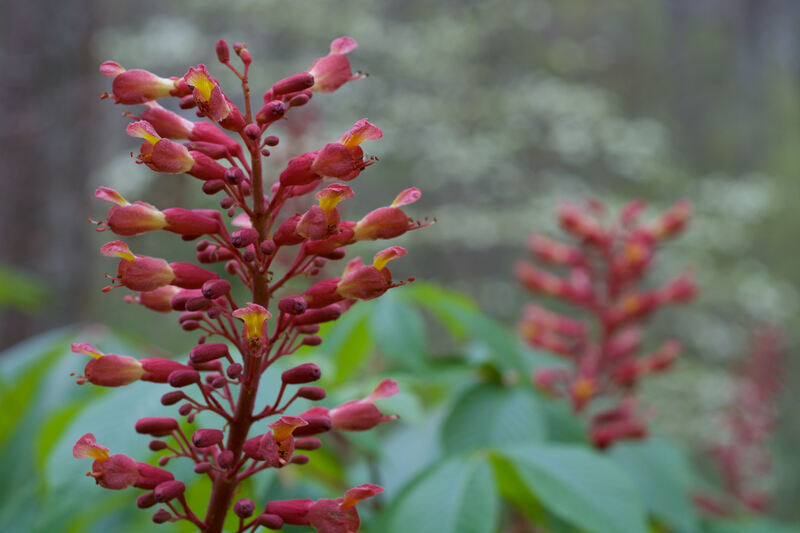
Photo Credit: Eric Hunt / Wikimedia Commons / CC BY-SA 4.0
Red buckeye, also called the firecracker plant, grows into a shrub or small tree throughout Alabama. It is a thyrse plant with showy red flowers that bloom very early in spring, attracting hummingbirds and bumble bees. In addition, squirrels love to notch on its nuts.
Due to its unique beauty, red buckeye is an excellent ornamental plant that enhances Alabama landscapes. Consider planting it near Joe Pye weed, which is native to several Alabama counties, including Madison, Mobile, Tuscaloosa, and Lee.
Plant type: Shrub/small tree
USDA Hardiness Zone: 5 to 9
Sun: Partial shade
Soil: Well-drained sand, loam, clay, limestone
Duration: Perennial
Foliage: Deciduous
Fragrance: None
Bloom time: March – May
Water needs: Medium – High
Mature height: 10 to 40 feet
Potential hazards: Seeds and young shoots are toxic to humans and children are the most susceptible. Its fruit contains toxins called saponins, but they don’t have much effect on humans and are also common in beans. However, the fruit may harm pets.
Maintenance needs: Red buckeyes enjoy liquid fertilizer, but once it’s 4-5 years old it no longer requires fertilization. Summer is the best time to prune and overwatering can cause leaf spot.
How to Choose Native Plants for Your Alabama Landscape
When choosing native plants for Alabama, please consider the following:
- Sun exposure: Before selecting plants, survey your yard for sunshine and place each plant in a spot appropriate for its sunlight preference.
- Maintenance: Although most native plants don’t take much to maintain, some native plants are virtually maintenance-free, while others require care such as fertilization and pruning. To further reduce yard work, check out low-maintenance landscaping ideas for Alabama.
- Aesthetic: Use colors, textures, and proportions to create your ideal outdoor ambiance.
- Region: Consider your area. Some native plants grow best in northern Alabama, while others are more suited for southern coastal landscapes.
- Hazards: Before choosing a plant, research its risks. For example, avoid toxic plants if you have small children or pets. Additionally, there are plants that people with severe allergies or asthma should skip.
- Lawn: Consider your grass type if you are planting by the lawn. For example, if your grass requires full sun, it’s best to avoid planting anything that will block the grass’s sunlight. If you like a lot of trees, some of the best grass types for Alabama tolerate shade.
- Wildlife: Know what animals your plant will attract. Many homeowners prefer plants that attract native birds and pollinators, while others want to avoid attracting certain herbivores and insects.
FAQ About Native Alabama Plants
The best plants native to Birmingham include the following:
- Oakleaf Hydrangea
- Southern Sugar Maple (Acer floridanum)
- Wavyleaf Purple Coneflower
- Largeflower Tickseed
- Flowering Dogwood
- Pussytoes
- Yellow Honeysuckle (Lonicera flava Sims)
If you live in Mobile or Baldwin, consider these native plants:
- Oakleaf Hydrangea
- Green-and-gold
- Red Buckeye
- Coral Honeysuckle
- Red maple
- Joe Pye Weed (Eutrochium Raf.)
And if you live close to the Gulf, these salt-tolerant Alabama native plants grow well in the southern part of the state:
- Coral Honeysuckle
- Seashore Paspalum (Paspalum vaginatum)
- Saltgrass (Distichlis Raf.)
- Baybean (Canavalia rosea)
If you live near the state’s capital, consider growing the following plants that are native to Montgomery County:
- Oakleaf Hydrangea
- Boxelder Maple
- Wavyleaf Purple Coneflower
- Flowering Dogwood
- Coral Honeysuckle
- Red Buckeye
- Red maple
If you live in Madison or Limestone County consider these North Alabama native plants:
- Coral Honeysuckle
- Red Buckeye
- Red Maple
- Ironweed (Vernonia Schreb.)
- Boxelder Maple
- Pussytoes
- Joe Pye Weed
Where to Find Native Plants in Alabama
You can view collections of Alabama native plants are the following places:
- North Alabama: Huntsville Botanic Garden, Hays Nature Preserve
- Central Alabama: Turkey Creek Nature Preserve, Ruffner Mountain Nature Preserve, Birmingham Botanical Gardens, Donald E. Davis Arboretum at Auburn University
- South Alabama: Troy University Herbarium, Hays Nature Preserve
And you can buy native plants at the following nurseries:
- North Alabama: North Alabama Nursery
- Central Alabama: Oak Street Garden Shop, Wildflower, White City Nursery, U.S. Alliance, Coosa Pines Corp., Petals from the Past
- South Alabama: Biophilia Nature Center
Additionally, many gardening groups have native seed exchange programs, and Birmingham Botanical Gardens has a seed exchange program for its members.
Consider hiring a landscaper to help you plan a native plant garden. A pro will determine what native plants are best for your yard, then build you the luscious landscape of your dreams. In addition, expert lawn care pros in Alabama can maintain your lawn and handle periodic yard clean-ups. Then, with the time you’ll save, you can hike to Noccalula Falls or watch a game at Bryant–Denny Stadium.
Main Photo Credit: Coreopsis / Pxfuel

